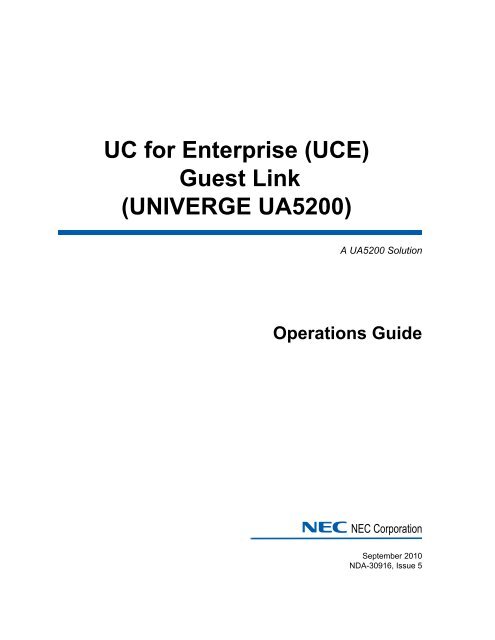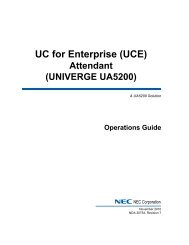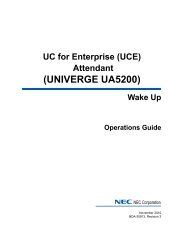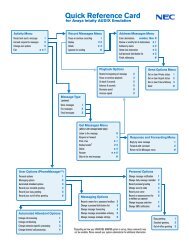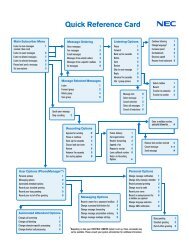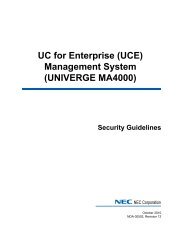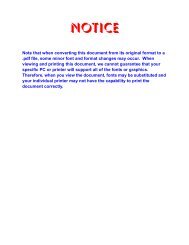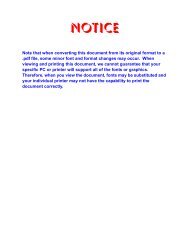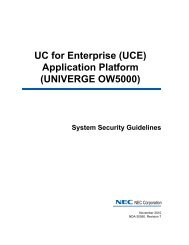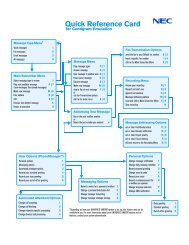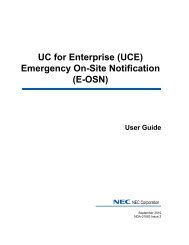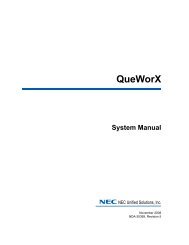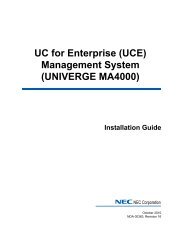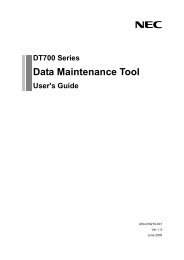UNIVERGE UA5200 Guest Link - NEC Corporation of America
UNIVERGE UA5200 Guest Link - NEC Corporation of America
UNIVERGE UA5200 Guest Link - NEC Corporation of America
Create successful ePaper yourself
Turn your PDF publications into a flip-book with our unique Google optimized e-Paper software.
UC for Enterprise (UCE)<br />
<strong>Guest</strong> <strong>Link</strong><br />
(<strong>UNIVERGE</strong> <strong>UA5200</strong>)<br />
A <strong>UA5200</strong> Solution<br />
Operations Guide<br />
<strong>NEC</strong> <strong>NEC</strong> <strong>Corporation</strong><br />
September 2010<br />
NDA-30916, Issue 5
Liability Disclaimer<br />
<strong>NEC</strong> <strong>Corporation</strong> reserves the right to change the specifications,<br />
functions, or features, at any time, without notice.<br />
<strong>NEC</strong> <strong>Corporation</strong> has prepared this document for the exclusive use <strong>of</strong><br />
its employees and customers. The information contained herein is the<br />
property <strong>of</strong> <strong>NEC</strong> <strong>Corporation</strong> and shall not be reproduced without prior<br />
written approval from <strong>NEC</strong> <strong>Corporation</strong><br />
© 2010 <strong>NEC</strong> <strong>Corporation</strong><br />
Micros<strong>of</strong>t and Windows® are registered<br />
trademarks <strong>of</strong> Micros<strong>of</strong>t <strong>Corporation</strong>.<br />
All other brand or product names are or may be trademarks or<br />
registered trademarks <strong>of</strong>, and are used to identify products or services<br />
<strong>of</strong>, their respective owners.
i<br />
Contents<br />
Introduction 1-1<br />
Overview . . . . . . . . . . . . . . . . . . . . . . . . . . . . . . . . . . . . . . . . . . . . . . . . . . . . . . 1-1<br />
How This Guide is Organized . . . . . . . . . . . . . . . . . . . . . . . . . . . . . . . . . . . . . . 1-1<br />
Installing <strong>Guest</strong> <strong>Link</strong> Service 2-1<br />
Before Starting the Installation Procedure. . . . . . . . . . . . . . . . . . . . . . . . . . . . . 2-1<br />
Hardware and S<strong>of</strong>tware Requirements. . . . . . . . . . . . . . . . . . . . . . . . . . . . . . . 2-1<br />
Installation Procedures for <strong>Guest</strong> <strong>Link</strong> Service . . . . . . . . . . . . . . . . . . . . . . . . . 2-2<br />
Configuring OW5000 3-1<br />
Assigning User Roles for OW5000 Admin . . . . . . . . . . . . . . . . . . . . . . . . . . . . 3-1<br />
Adding Hotel PBX Configuration . . . . . . . . . . . . . . . . . . . . . . . . . . . . . . . . . . . . 3-2<br />
Adding an Organization. . . . . . . . . . . . . . . . . . . . . . . . . . . . . . . . . . . . . . . . . . . 3-6<br />
Adding Locations. . . . . . . . . . . . . . . . . . . . . . . . . . . . . . . . . . . . . . . . . . . . . . . . 3-9<br />
Creating New Parent Location . . . . . . . . . . . . . . . . . . . . . . . . . . . . . . . . . . . . . 3-9<br />
Creating a New Hotel Room . . . . . . . . . . . . . . . . . . . . . . . . . . . . . . . . . . . . . . 3-11<br />
Adding a Hotel PBX to <strong>Guest</strong> <strong>Link</strong> . . . . . . . . . . . . . . . . . . . . . . . . . . . . . . . . . 3-12<br />
PMS Site Management . . . . . . . . . . . . . . . . . . . . . . . . . . . . . . . . . . . . . . . . . . 3-14<br />
<br />
Configuring <strong>Guest</strong> Retention Days . . . . . . . . . . . . . . . . . . . . . . . . . . . . . . . . . 3-16<br />
<strong>UA5200</strong> <strong>Guest</strong> <strong>Link</strong> Operations Guide - Revision 5
ii<br />
Contents<br />
Configuring <strong>Guest</strong> <strong>Link</strong> Basic . . . . . . . . . . . . . . . . . . . . . . . . . . . . . . . . . . . . . 3-20<br />
Limitations <strong>of</strong> <strong>Guest</strong> <strong>Link</strong> Basic . . . . . . . . . . . . . . . . . . . . . . . . . . . . . . . . . . . . 3-22<br />
Configuring <strong>Guest</strong> <strong>Link</strong> Agilysys LMS 4-1<br />
Procedures for Configuring <strong>Guest</strong> <strong>Link</strong> Agilysys LMS. . . . . . . . . . . . . . . . . . . . 4-1<br />
Starting <strong>Guest</strong> <strong>Link</strong> Adapter . . . . . . . . . . . . . . . . . . . . . . . . . . . . . . . . . . . . . . . 4-2<br />
<strong>Guest</strong> <strong>Link</strong> Adapter Controller. . . . . . . . . . . . . . . . . . . . . . . . . . . . . . . . . . . . . . 4-2<br />
Status Tab. . . . . . . . . . . . . . . . . . . . . . . . . . . . . . . . . . . . . . . . . . . . . . . . . . . . . 4-2<br />
Configuration Tab . . . . . . . . . . . . . . . . . . . . . . . . . . . . . . . . . . . . . . . . . . . . . . . 4-4<br />
View Log Tab . . . . . . . . . . . . . . . . . . . . . . . . . . . . . . . . . . . . . . . . . . . . . . . . . . 4-7<br />
Initial Data Population 5-1<br />
Procedures for Initial Data Population. . . . . . . . . . . . . . . . . . . . . . . . . . . . . . . . 5-1<br />
Loading Data with Agilysys LMS PMS . . . . . . . . . . . . . . . . . . . . . . . . . . . . . . . 5-1<br />
Loading Data for Micros and <strong>Guest</strong> <strong>Link</strong> Basic. . . . . . . . . . . . . . . . . . . . . . . . . 5-1<br />
Migrating Data from a Legacy <strong>NEC</strong> HCS System. . . . . . . . . . . . . . . . . . . . . . . 5-2<br />
Exporting Tables from HCS . . . . . . . . . . . . . . . . . . . . . . . . . . . . . . . . . . . . . . . 5-2<br />
Importing Exported Data into OW5000 . . . . . . . . . . . . . . . . . . . . . . . . . . . . . . . 5-3<br />
NEAX Command Assignments 6-1<br />
NEAX 2400 Commands . . . . . . . . . . . . . . . . . . . . . . . . . . . . . . . . . . . . . . . . . . 6-1<br />
NEAX Command Assignments Required Settings for <strong>UA5200</strong> <strong>Guest</strong> <strong>Link</strong> <br />
Basic . . . . . . . . . . . . . . . . . . . . . . . . . . . . . . . . . . . . . . . . . . . . . . . . . . . . . . . . . 6-1<br />
ASYD SYS 1 . . . . . . . . . . . . . . . . . . . . . . . . . . . . . . . . . . . . . . . . . . . . . . . . . . . 6-1<br />
<strong>UA5200</strong> <strong>Guest</strong> <strong>Link</strong> Operations Guide - Revision 5
iii<br />
Figures<br />
Figure Title Page<br />
2-1 <strong>UA5200</strong> <strong>Guest</strong> <strong>Link</strong> - Preparing to Install the Program. . . . . . . . . . . . . . . 2-2<br />
2-2 <strong>UA5200</strong> <strong>Guest</strong> <strong>Link</strong> - Welcome InstallShield . . . . . . . . . . . . . . . . . . . . . . 2-3<br />
2-3 <strong>UA5200</strong> <strong>Guest</strong> <strong>Link</strong> - Database Server . . . . . . . . . . . . . . . . . . . . . . . . . . 2-3<br />
2-4 <strong>UA5200</strong> <strong>Guest</strong> <strong>Link</strong> - Ready to Install . . . . . . . . . . . . . . . . . . . . . . . . . . . 2-4<br />
2-5 <strong>UA5200</strong> <strong>Guest</strong> <strong>Link</strong> - Installing . . . . . . . . . . . . . . . . . . . . . . . . . . . . . . . . . 2-5<br />
2-6 <strong>UA5200</strong> <strong>Guest</strong> <strong>Link</strong> - InstallShield Wizard Completed . . . . . . . . . . . . . . . 2-6<br />
3-1 OW5000 Options . . . . . . . . . . . . . . . . . . . . . . . . . . . . . . . . . . . . . . . . . . . 3-2<br />
3-2 OW5000 - Platform. . . . . . . . . . . . . . . . . . . . . . . . . . . . . . . . . . . . . . . . . . 3-3<br />
3-3 PBX Management - Add New PBX . . . . . . . . . . . . . . . . . . . . . . . . . . . . . 3-3<br />
3-4 PBX Management - PBX Settings . . . . . . . . . . . . . . . . . . . . . . . . . . . . . . 3-4<br />
3-5 OW5000 - Directory Configuration . . . . . . . . . . . . . . . . . . . . . . . . . . . . . . 3-6<br />
3-6 Organization Management . . . . . . . . . . . . . . . . . . . . . . . . . . . . . . . . . . . . 3-7<br />
3-7 Organization Management - Add New . . . . . . . . . . . . . . . . . . . . . . . . . . . 3-8<br />
3-8 Location Management Screen . . . . . . . . . . . . . . . . . . . . . . . . . . . . . . . . 3-10<br />
3-9 Add New Location Screen . . . . . . . . . . . . . . . . . . . . . . . . . . . . . . . . . . . 3-10<br />
3-10 Creating New Hotel Room . . . . . . . . . . . . . . . . . . . . . . . . . . . . . . . . . . . 3-11<br />
3-11 OW5000 Directory Configuration . . . . . . . . . . . . . . . . . . . . . . . . . . . . . . 3-12<br />
3-12 Hotel PBX Assignment - Assign PBX to Hotel . . . . . . . . . . . . . . . . . . . . 3-12<br />
3-13 Hotel PBX Assignment - Selection . . . . . . . . . . . . . . . . . . . . . . . . . . . . . 3-13<br />
3-14 Hotel PBX Assignment - PBX Mapped to Hotel Successfully. . . . . . . . . 3-14<br />
3-15 PMS Site Management. . . . . . . . . . . . . . . . . . . . . . . . . . . . . . . . . . . . . . 3-15<br />
3-16 Assign PMS Hotel. . . . . . . . . . . . . . . . . . . . . . . . . . . . . . . . . . . . . . . . . . 3-15<br />
3-17 <strong>Guest</strong> Purge Dialog Box . . . . . . . . . . . . . . . . . . . . . . . . . . . . . . . . . . . . . 3-17<br />
3-18 Wake-Up Service Settings . . . . . . . . . . . . . . . . . . . . . . . . . . . . . . . . . . . 3-21<br />
3-19 Enabling <strong>Guest</strong> <strong>Link</strong> Basic . . . . . . . . . . . . . . . . . . . . . . . . . . . . . . . . . . . 3-21<br />
3-20 <strong>Guest</strong> <strong>Link</strong> Basic Message . . . . . . . . . . . . . . . . . . . . . . . . . . . . . . . . . . . 3-22<br />
4-1 <strong>Guest</strong><strong>Link</strong> Adapter Controller - Status Tab. . . . . . . . . . . . . . . . . . . . . . . . 4-3<br />
4-2 <strong>Guest</strong><strong>Link</strong> Adapter Controller - Configuration Tab . . . . . . . . . . . . . . . . . . 4-5<br />
4-3 <strong>Guest</strong><strong>Link</strong> Adapter Controller - View Log . . . . . . . . . . . . . . . . . . . . . . . . . 4-7<br />
<strong>UA5200</strong> <strong>Guest</strong> <strong>Link</strong> Operations Guide - Revision 5
iv<br />
Figures<br />
<strong>UA5200</strong> <strong>Guest</strong> <strong>Link</strong> Operations Guide - Revision 5
v<br />
Tables<br />
Table Title Page<br />
3-1 <strong>Guest</strong> Purge Field Descriptions . . . . . . . . . . . . . . . . . . . . . . . . . . . . . . . 3-18<br />
4-1 Status Tab - Connection Status Section Description. . . . . . . . . . . . . . . . 4-3<br />
4-2 Status Tab - <strong>Guest</strong> <strong>Link</strong> Service Section Description . . . . . . . . . . . . . . . 4-4<br />
4-3 Configuration Tab - Property Site Data Section Description . . . . . . . . . . 4-5<br />
4-4 Configuration Tab - Other <strong>Guest</strong> Settings Section Description . . . . . . . . 4-6<br />
5-1 HCS to Export . . . . . . . . . . . . . . . . . . . . . . . . . . . . . . . . . . . . . . . . . . . . . 5-2<br />
<strong>UA5200</strong> <strong>Guest</strong> <strong>Link</strong> Operations Guide - Revision 5
vi<br />
Tables<br />
<strong>UA5200</strong> <strong>Guest</strong> <strong>Link</strong> Operations Guide - Revision 5
Introduction 1-1<br />
Introduction<br />
Chapter Topics<br />
Welcome to the <strong>Guest</strong> <strong>Link</strong> Operations Guide. This guide provides the<br />
procedures necessary to operate the <strong>Guest</strong> <strong>Link</strong> application. The<br />
following topics are included in this chapter.<br />
• Overview<br />
• How This Guide is Organized<br />
Overview<br />
<strong>Guest</strong> <strong>Link</strong> allows Hotel/Hospitality Systems to populate guest data into<br />
the <strong>UA5200</strong> database by connecting to the hotel's Property Management<br />
System (PMS).<br />
When the database is populated with guests and room/extension data,<br />
the <strong>UA5200</strong> Client can transfer calls to that guest.<br />
<strong>Guest</strong> <strong>Link</strong> is composed <strong>of</strong> "adapters" that communicate with different<br />
PMS systems as well as having an option to populate guest data from<br />
the <strong>NEC</strong> NEAX 2400 PBX, if a supported PMS system is not available.<br />
How This Guide is Organized<br />
Chapter 1<br />
Introduction<br />
Chapter 2<br />
Installing <strong>Guest</strong> <strong>Link</strong> Service<br />
Chapter 3<br />
Configuring OW5000<br />
Chapter 4<br />
Configuring <strong>Guest</strong> <strong>Link</strong><br />
Agilysys LMS<br />
Chapter 5<br />
Initial Data Population<br />
Chapter 6<br />
NEAX Command<br />
Assignments<br />
This chapter provides a product overview, and outlines the organization<br />
and chapter layout for the <strong>Guest</strong> <strong>Link</strong> application.<br />
This chapter describes the initial requirements for installing <strong>Guest</strong> <strong>Link</strong><br />
Service, along with the step-by-step procedures needed to install the<br />
application.<br />
This chapter discusses OW5000 Admin-><strong>UA5200</strong>-><strong>Guest</strong> <strong>Link</strong><br />
configuration.<br />
This chapter provides the steps and information needed to start and<br />
configure the <strong>Guest</strong> <strong>Link</strong> application.<br />
This chapter provides procedures used in initial data population, data<br />
migration, and importing and exporting data.<br />
This chapter provides NEAX command assignment required settings for<br />
<strong>UA5200</strong> <strong>Guest</strong> <strong>Link</strong> basic.<br />
<strong>UA5200</strong> <strong>Guest</strong> <strong>Link</strong> Operations Guide - Revision 5
1-2 Introduction<br />
<strong>UA5200</strong> <strong>Guest</strong> <strong>Link</strong> Operations Guide - Revision 5
Installing <strong>Guest</strong> <strong>Link</strong> Service 2-1<br />
Installing <strong>Guest</strong> <strong>Link</strong> Service<br />
Chapter Topics<br />
This chapter provides step-by-step procedures to install the <strong>Guest</strong> <strong>Link</strong><br />
s<strong>of</strong>tware. Descriptions and procedures are found in the following<br />
sections <strong>of</strong> this chapter.<br />
• Before Starting the Installation Procedure<br />
• Installation Procedures for <strong>Guest</strong> <strong>Link</strong> Service<br />
Before Starting the Installation Procedure<br />
This section describes the required components that must be in place<br />
before installing the <strong>Guest</strong> <strong>Link</strong> s<strong>of</strong>tware. OW5000 must be installed<br />
prior to installing <strong>Guest</strong> <strong>Link</strong>, so that the database is created and ready<br />
for population. In order for operators to use the data coming from <strong>Guest</strong><br />
<strong>Link</strong>, the <strong>UA5200</strong> Attendant must also be installed.<br />
Hardware and S<strong>of</strong>tware Requirements<br />
Prior to installing any s<strong>of</strong>tware, refer to the Requirements section in the<br />
OW5000 Configuration Guide for more details about the Application<br />
Environment requirements.<br />
<strong>UA5200</strong> <strong>Guest</strong> <strong>Link</strong> Operations Guide - Revision 5
2-2 Installing <strong>Guest</strong> <strong>Link</strong> Service<br />
Installation Procedures for <strong>Guest</strong> <strong>Link</strong> Service<br />
Use the following steps to install the <strong>Guest</strong> <strong>Link</strong> Service s<strong>of</strong>tware.<br />
Step 1<br />
Place the UCE DVD into the computer’s DVD-ROM drive. On most<br />
computers, setup will automatically start when the DVD is loaded. If<br />
Autorun is not enabled on the computer, then do the following:<br />
—After placing the UCE DVD into the computer’s DVD-ROM drive, open<br />
Windows Explorer and double-click the DVD-ROM drive icon.<br />
—In the DVD-ROM file list, double-click the Setup.exe file in the <strong>Guest</strong><br />
<strong>Link</strong> folder. A Master Installation Menu displays.<br />
Step 2<br />
From the Master Installation Menu, choose the <strong>UA5200</strong> <strong>Guest</strong> <strong>Link</strong><br />
Service option to start the installation process. Figure 2-1 displays.<br />
When installing from a web browser, the browser must allow execution <strong>of</strong> Java<br />
applications and allow pop-ups.<br />
NOTE<br />
Figure 2-1 <strong>UA5200</strong> <strong>Guest</strong> <strong>Link</strong> - Preparing to Install the Program<br />
Step 3<br />
The system prepares the installation. When it stops, Figure 2-2 displays.<br />
<strong>UA5200</strong> <strong>Guest</strong> <strong>Link</strong> Operations Guide - Revision 5
Installing <strong>Guest</strong> <strong>Link</strong> Service 2-3<br />
Figure 2-2 <strong>UA5200</strong> <strong>Guest</strong> <strong>Link</strong> - Welcome InstallShield<br />
Step 4<br />
Click Next. Figure 2-3 displays.<br />
Figure 2-3 <strong>UA5200</strong> <strong>Guest</strong> <strong>Link</strong> - Database Server<br />
<strong>UA5200</strong> <strong>Guest</strong> <strong>Link</strong> Operations Guide - Revision 5
2-4 Installing <strong>Guest</strong> <strong>Link</strong> Service<br />
Step 5<br />
Step 6<br />
Step 7<br />
Step 8<br />
Select the database server or click Browse to see a list <strong>of</strong> all database<br />
servers.<br />
Select the connection method. If using Server authentication connection,<br />
go to Enter the Login ID and Password.. If using Windows authentication,<br />
go to Click Next. Figure 2-4 displays..<br />
Enter the Login ID and Password.<br />
Click Next. Figure 2-4 displays.<br />
Figure 2-4 <strong>UA5200</strong> <strong>Guest</strong> <strong>Link</strong> - Ready to Install<br />
Step 9<br />
Click Install. <strong>UA5200</strong> <strong>Guest</strong> <strong>Link</strong> - Installing displays.<br />
<strong>UA5200</strong> <strong>Guest</strong> <strong>Link</strong> Operations Guide - Revision 5
Installing <strong>Guest</strong> <strong>Link</strong> Service 2-5<br />
Figure 2-5 <strong>UA5200</strong> <strong>Guest</strong> <strong>Link</strong> - Installing<br />
When <strong>UA5200</strong> <strong>Guest</strong> <strong>Link</strong> finishes installing, <strong>UA5200</strong> <strong>Guest</strong> <strong>Link</strong> -<br />
InstallShield Wizard Completed displays.<br />
<strong>UA5200</strong> <strong>Guest</strong> <strong>Link</strong> Operations Guide - Revision 5
2-6 Installing <strong>Guest</strong> <strong>Link</strong> Service<br />
Figure 2-6 <strong>UA5200</strong> <strong>Guest</strong> <strong>Link</strong> - InstallShield Wizard Completed<br />
Step 10<br />
Click Finish to complete the installation. The dialog box closes and the<br />
<strong>Guest</strong> <strong>Link</strong> Service application is now installed.<br />
<strong>UA5200</strong> <strong>Guest</strong> <strong>Link</strong> Operations Guide - Revision 5
Configuring OW5000 3-1<br />
Configuring OW5000<br />
Chapter Topics<br />
In order for <strong>Guest</strong> <strong>Link</strong> to enter guest, room and extension information<br />
in the OW5000 Database for use by <strong>UA5200</strong>, the OW5000 Administrator<br />
must be configured with the Hotel PBX and an Organization created to<br />
match the desired Site Identification name preferred for the PMS<br />
connection.<br />
The name <strong>of</strong> this Organization must be the same name entered as the<br />
Site Identification in the <strong>Guest</strong> <strong>Link</strong> Adapter Controller Configuration<br />
tab. The Organization is then mapped to a PBX.<br />
The following topics are included in this chapter:<br />
• Adding Hotel PBX Configuration<br />
• Adding an Organization<br />
• Adding Locations<br />
• Adding a Hotel PBX to <strong>Guest</strong> <strong>Link</strong><br />
• PMS Site Management<br />
• Configuring <strong>Guest</strong> <strong>Link</strong> Basic<br />
NOTE<br />
The following procedures only describe the steps needed to successfully configure<br />
<strong>Guest</strong> <strong>Link</strong>. See the OW5000 System Manual for procedures on how to configure<br />
other OW5000 Admin items<br />
Assigning User Roles for OW5000 Admin<br />
In order for the <strong>Guest</strong> <strong>Link</strong> options to be visible, user roles need to be<br />
assigned in OW5000 Admin. To assign user roles, follow the steps<br />
below.<br />
Step 1<br />
Step 2<br />
Step 3<br />
Step 4<br />
Ensure Wake-Up Service is installed. This enables the Wake-Up<br />
Administrator application role.<br />
Login as the default OW5000 Admin account (see the Univerge OW5000<br />
Installation Guide for details). This account is automatically assigned the<br />
Wake-Up Administrator role and will be authorized to view the <strong>UA5200</strong>-<br />
><strong>Guest</strong> <strong>Link</strong> menu option.<br />
Optionally, assign a new user to have the Wake-Up Administrator<br />
application role.<br />
Login to OW5000 Administrator using a user account that has the Wake-<br />
Up Administrator application role.<br />
A user must have the OW5000 Administrator role to configure PBX Organization,<br />
and Location data.<br />
NOTE<br />
<strong>UA5200</strong> <strong>Guest</strong> <strong>Link</strong> Operations Guide - Revision 5
3-2 Configuring OW5000<br />
Adding Hotel PBX Configuration<br />
Use the following steps to add the Hotel PBX.<br />
Step 1<br />
Step 2<br />
Logon to the OW5000 Admin with a user account that has OW5000<br />
Admin privileges.<br />
Select OW5000 from the OW5000 Administrator menu to <br />
(see Figure 3-1).<br />
The PBX may have already been created during the installation <strong>of</strong> the OW5000<br />
platform.<br />
NOTE<br />
Figure 3-1 OW5000 Options<br />
Step 3<br />
Select Platform from the menu, and then select PBXs from the<br />
submenu (see Figure 3-2). Figure 3-3 displays.<br />
<strong>UA5200</strong> <strong>Guest</strong> <strong>Link</strong> Operations Guide - Revision 5
Configuring OW5000 3-3<br />
Figure 3-2 OW5000 - Platform<br />
Figure 3-3 PBX Management - Add New PBX<br />
Step 4 Click Add New PBX to display Figure 3-4.<br />
<strong>UA5200</strong> <strong>Guest</strong> <strong>Link</strong> Operations Guide - Revision 5
3-4 Configuring OW5000<br />
Figure 3-4 PBX Management - PBX Settings<br />
Fields which must be completed are designated with an asterisk (*).<br />
NOTE<br />
Step 5<br />
Step 6<br />
Enter a Name for the PBX in the PBX Name field. This is a label used to<br />
identify the PBX. It is displayed in various list boxes to identify the<br />
location <strong>of</strong> extensions, and therefore should most likely be made to<br />
describe the site where it is located.Enter the IP address <strong>of</strong> the PBX in<br />
the IP Address field. If you do not know the PBX IP address, contact<br />
your local PBX system administrator. Determining the IP address <strong>of</strong> your<br />
PBX depends on the particular type <strong>of</strong> PBX selected, as shown in (Step<br />
6).<br />
Enter the PBX ID for the PBX in the Office Code (PBX Id) field. This is<br />
the PBX’s <strong>of</strong>fice code. This ID is used by applications to match<br />
extensions provided in OAI messages sent from the PBX with a given<br />
extension in the OW5000 Database. This ID uniquely identifies the PBX<br />
<strong>UA5200</strong> <strong>Guest</strong> <strong>Link</strong> Operations Guide - Revision 5
Configuring OW5000 3-5<br />
Step 7<br />
Step 8<br />
and is critical in a CCIS environment that does not have a unique<br />
numbering plan (where extensions can have the same number in more<br />
than one networked PBX).<br />
Select an available Client/Server Port from the drop-down list. This port<br />
is used by remote applications to communicate with the OAI Server<br />
using TCP/IP. Choose a value, in the range 44000-44100, that does not<br />
conflict with other programs or configured PBX’s using that value. It is<br />
possible to type 'netstat -a -n' from a DOS command prompt to see<br />
if ports are already in use.<br />
Select the PBX Type from one <strong>of</strong> the options in the PBX Type drop-down<br />
list. It is important to select the correct type because applications rely on<br />
this information for both licensing and functionality.<br />
Step 9 Select Dial Code from drop-down list. The default value is None.<br />
Step 10<br />
Step 11<br />
Step 12<br />
Step 13<br />
Step 14<br />
Step 15<br />
Step 16<br />
Step 17<br />
Select the Split Call Forward check box if this feature is configured on<br />
your PBX. Split Call Forwarding enables Dterm telephone users to set<br />
different call forwarding patterns for internal versus external calls.<br />
Select a Location from the drop-down list. The location must be<br />
configured before this step. For more information, see the OW5000<br />
System Manual, “Configuring Locations”.<br />
Select the proper PBX Reconnect Delay time from the drop-down list.<br />
<br />
When the OW5000 realizes a disconnection between the server and the<br />
PBX, this parameter (a delay timer), determines how much time should<br />
pass until the next reconnect request is sent to the PBX. The default<br />
value is 30 seconds.<br />
Select the proper Heartbeat Timeout value from the drop-down list. This<br />
parameter indicates the heartbeat.<br />
Check the UGN (User Group Number) if the IP centrex feature is used.<br />
Enter the Prefix number. This parameter typically consists <strong>of</strong> Access<br />
Number + Office Code (PBX ID). This parameter is mandatory in multi-<br />
PBX systems to identify the same extension number.<br />
Enter the SIP Server IP Address (Port). The IP Address <strong>of</strong> SP must be<br />
assigned in this edit box for SV7000 and SR-MGC. Enter the SIP-BOX<br />
IP address for the IPX and IPS. All SIP Server IP addresses must be<br />
entered if there is more than one SIP Server. In the VRRP environment,<br />
both physical and logical IP addresses must be entered. The Default Port<br />
number is 5060 for SP.<br />
Click Add to add a port, or Remove to remove a port.<br />
UGN, Prefix, and SIP Server IP Address (Port) fields are needed for the SIP<br />
Presence function.<br />
NOTE<br />
<br />
<br />
<strong>UA5200</strong> <strong>Guest</strong> <strong>Link</strong> Operations Guide - Revision 5
3-6 Configuring OW5000<br />
Step 18<br />
Do one <strong>of</strong> the following:<br />
—Click Apply to save the information.<br />
—Click Done to add the PBX Configuration and close the dialog box.<br />
—Click Cancel to exit without saving the new PBX configuration.<br />
Adding an Organization<br />
Use the following steps to add the organization (hotel).<br />
Step 1<br />
Step 2<br />
Select OW5000 from the OW5000 Administrator Control Panel to display<br />
an OW5000 Options dialog box (see Figure 3-1).<br />
Select Directory from the menu, and then select Organizations from<br />
the submenu (see Figure 3-5). Figure 3-6 displays.<br />
Figure 3-5 OW5000 - Directory Configuration<br />
<strong>UA5200</strong> <strong>Guest</strong> <strong>Link</strong> Operations Guide - Revision 5
Configuring OW5000 3-7<br />
Figure 3-6 Organization Management<br />
Step 3<br />
Select the root Organizations level, then select Add New. This will<br />
create a new organization level. Figure 3-7 displays.<br />
<strong>UA5200</strong> <strong>Guest</strong> <strong>Link</strong> Operations Guide - Revision 5
3-8 Configuring OW5000<br />
Figure 3-7 Organization Management - Add New<br />
Step 4<br />
Select the Internal option button from the Organization Type drop down<br />
list.<br />
<strong>UA5200</strong> <strong>Guest</strong> <strong>Link</strong> Operations Guide - Revision 5
Configuring OW5000 3-9<br />
Step 5<br />
Enter the name <strong>of</strong> the organization. If the selected PMS is Agilysys LMS,<br />
the Organization name should match the name used in the Site Id field<br />
on the <strong>Guest</strong> <strong>Link</strong> Adapter Controller Configuration tab.<br />
It is very important that you enter an organization name that matches the Site Id field<br />
in the <strong>Guest</strong> <strong>Link</strong> Adapter Controller during this step.<br />
IMPORTANT<br />
Step 6<br />
Step 7<br />
Select the Type <strong>of</strong> organization as Hotel from the drop-down list.<br />
Enter any desired Notes.<br />
Adding Locations<br />
Locations representing hotel rooms and their extensions can be added<br />
through OW5000 Admin, OW5000 DB Tool or during Room/Extension<br />
download with some Property Management Systems.<br />
With Micros-Fidelio and <strong>Guest</strong> <strong>Link</strong> Basic, you must import the room/<br />
extension data before executing the application.<br />
REFERENCE<br />
Please refer to the OW5000 Configuration Guide for instructions on how to use the<br />
OW5000 DB Tool.<br />
Follow the procedures below to create a New Parent Location and a<br />
New Hotel Room using OW5000 Administrator.<br />
Creating New Parent Location<br />
Step 1<br />
Navigate to OW5000 > Directory > Locations. Figure 3-8 displays.<br />
<strong>UA5200</strong> <strong>Guest</strong> <strong>Link</strong> Operations Guide - Revision 5
3-10 Configuring OW5000<br />
Figure 3-8 Location Management Screen<br />
Step 2<br />
Click Add New. Figure 3-9 displays.<br />
Figure 3-9 Add New Location Screen<br />
<strong>UA5200</strong> <strong>Guest</strong> <strong>Link</strong> Operations Guide - Revision 5
Configuring OW5000 3-11<br />
Step 3<br />
Enter a Name for the Parent Location.<br />
Naming the Parent Location the same as the Hotel organization is recommended.<br />
This helps keep the data organized.<br />
TIP<br />
Step 4<br />
Step 5<br />
Choose Hotel Building from the Type drop down list.<br />
Click Apply and then Done to save the location and return to the<br />
Location Management screen.<br />
Creating a New Hotel Room<br />
Step 1<br />
Step 2<br />
On the Location Management Screen, to select the Parent Location<br />
that was just created, click >.<br />
Click Add New. Figure 3-10 displays.<br />
Figure 3-10 Creating New Hotel Room<br />
Step 3<br />
Step 4<br />
Enter a Hotel Room name in the Name field.<br />
Click Add New under PHONE NUMBERS to add an extension for this<br />
room.<br />
<br />
<strong>UA5200</strong> <strong>Guest</strong> <strong>Link</strong> Operations Guide - Revision 5
3-12 Configuring OW5000<br />
Step 5<br />
Click Apply.<br />
OR<br />
Browse back to the Organization (OW5000 > Directory ><br />
Organizations and look up the organization related to this hotel room.<br />
Edit the parent organization and link the location to that organization by<br />
selecting Add New under the LOCATIONS section. (<strong>Link</strong>s hotel room to<br />
the hotel).<br />
Adding a Hotel PBX to <strong>Guest</strong> <strong>Link</strong><br />
Use the following steps to link the Hotel PBX and Organization (Site Id).<br />
Step 1<br />
Step 2<br />
Select <strong>UA5200</strong> from the OW5000 Administrator menu to display an<br />
OW5000 Options dialog box (see Figure 3-1).<br />
Select <strong>Guest</strong> <strong>Link</strong> from the menu, and then select Hotel PBX from the<br />
submenu (see Figure 3-11). Figure 3-12 displays.<br />
Figure 3-11 OW5000 Directory Configuration<br />
Figure 3-12 Hotel PBX Assignment - Assign PBX to Hotel<br />
<strong>UA5200</strong> <strong>Guest</strong> <strong>Link</strong> Operations Guide - Revision 5
Configuring OW5000 3-13<br />
Step 3<br />
Click Assign PBX to Hotel. Figure 3-13 displays.<br />
Figure 3-13 Hotel PBX Assignment - Selection<br />
Step 4<br />
Select the hotel Name from the drop-down menu.<br />
Only Organizations names <strong>of</strong> the type Hotel will display in this drop-down.<br />
NOTE<br />
Step 5<br />
Step 6<br />
Select the PBX from the drop-down menu.<br />
Do one <strong>of</strong> the following:<br />
—Click Apply to update the changes. Figure 3-14 displays.<br />
—Click Done to exit the dialog box.<br />
—Click Cancel to exit without saving the changes.<br />
<strong>UA5200</strong> <strong>Guest</strong> <strong>Link</strong> Operations Guide - Revision 5
3-14 Configuring OW5000<br />
Figure 3-14 Hotel PBX Assignment - PBX Mapped to Hotel Successfully<br />
PMS Site Management<br />
<strong>Guest</strong> <strong>Link</strong> allows Hotel/Hospitality Systems to populate guest data into<br />
the <strong>UA5200</strong> database by connecting to the hotel's Property Management<br />
System (PMS).<br />
Perform the following steps to allocate a supported PMS to the system.<br />
Step 1 Navigate to <strong>UA5200</strong> > <strong>Guest</strong> <strong>Link</strong> > PMS Site Management. Figure 3-<br />
15 displays.<br />
<strong>UA5200</strong> <strong>Guest</strong> <strong>Link</strong> Operations Guide - Revision 5
Configuring OW5000 3-15<br />
Figure 3-15 PMS Site Management<br />
Step 2<br />
Click Assign PMS Hotel. Figure 3-16 displays.<br />
Figure 3-16 Assign PMS Hotel<br />
Step 3<br />
Step 4<br />
Select PMS Site from the drop down list <strong>of</strong> defined organizations <strong>of</strong> type<br />
Hotel.<br />
Select PMS Type from the drop down list <strong>of</strong> supported vendors.<br />
Currently, there are two PMS types in the list, Agilysys LMS and Micros-<br />
FIAS.<br />
NOTE<br />
If the selected PMS Type is Agilysys LMS, the Remote and Local fields are not used;<br />
however, a properly formatted IP address and port must be entered. The Remote<br />
and Local fields are entered in the <strong>Guest</strong> <strong>Link</strong> Adapter Controller Panel as the High<br />
Priority and Low Priority fields.<br />
<strong>UA5200</strong> <strong>Guest</strong> <strong>Link</strong> Operations Guide - Revision 5
3-16 Configuring OW5000<br />
Step 5<br />
Step 6<br />
Step 7<br />
Step 8<br />
Enter the published IP address <strong>of</strong> the PMS System that <strong>Guest</strong> <strong>Link</strong> will<br />
connect to in Remote IP Address (required field).<br />
Enter the Port associated with the Remote IP Address in the Remote<br />
Port (required field).<br />
Enter the Local IP Address field.<br />
Enter the port associated with the Local IP Address in the Local Port<br />
field.<br />
NOTE<br />
The Local IP Address and the Local Port fields are not used at this time; however, in<br />
order to complete this procedure, these fields cannot remain empty. Therefore, a<br />
properly formatted IP address and port must be entered in order for the process to<br />
continue.<br />
Step 9<br />
Step 10<br />
Check the Active box to make this configuration active. When <strong>Guest</strong><br />
<strong>Link</strong> is restarted, it will attempt connect based on this configuration.<br />
Click Apply.<br />
Configuring <strong>Guest</strong> Retention Days<br />
This option is to set the number <strong>of</strong> days a guest will remain in the<br />
database after the guest has checked out before the guest and any<br />
related wake-up information will be removed.<br />
Log on to the OW5000 Administrator program. Once you are logged in<br />
to OW5000 Administrator, follow this path to configure the guest<br />
retention days: OW5000 > Scheduler and then select the <strong>Guest</strong><br />
Purge tab. A <strong>Guest</strong> Purge dialog box displays (Figure 3-17).<br />
<strong>UA5200</strong> <strong>Guest</strong> <strong>Link</strong> Operations Guide - Revision 5
Configuring OW5000 3-17<br />
Figure 3-17 <strong>Guest</strong> Purge Dialog Box<br />
Step 1<br />
Step 2<br />
Step 3<br />
Step 4<br />
Enter a description for the guest purge record in the Description field.<br />
Enter the number <strong>of</strong> days the guest records will be kept In the Retention<br />
Days field. A value <strong>of</strong> 1 through 365 must be entered.<br />
The Enabled check box turns <strong>Guest</strong> Purge on or <strong>of</strong>f. Check the<br />
Enabled box to allow the purging <strong>of</strong> guest records. Leave the box blank<br />
to keep checked-out guests in the directory indefinitely.<br />
To purge the records on a recurring basis, select Recurring from the<br />
Recurring Type drop-down list and proceed to Step 8. To purge the<br />
records one time, select One Time from the Recurring Type drop-down<br />
list and proceed to Step 5.<br />
NOTE<br />
If One Time is selected, the section Schedule Time becomes available for data<br />
entry. If Recurring is selected, the Recurrence Pattern section becomes available<br />
for data entry.<br />
Step 5<br />
Step 6<br />
Step 7<br />
In the Schedule Time section, enter the Start Date by clicking on the<br />
Calender icon.<br />
Enter the Start Time.<br />
Click Apply to save the <strong>Guest</strong> Purge Schedule.<br />
<strong>UA5200</strong> <strong>Guest</strong> <strong>Link</strong> Operations Guide - Revision 5
3-18 Configuring OW5000<br />
Step 8<br />
In the Recurrence Section, select Daily, Weekly, or Monthly to<br />
schedule how <strong>of</strong>ten guest purge will occur.<br />
REFERENCE<br />
The remainder <strong>of</strong> the Recurrence Pattern options change depending on how <strong>of</strong>ten<br />
the guest purge is scheduled to occur. Refer to Table 3-1 for field descriptions and<br />
values for each type <strong>of</strong> recurrence.<br />
Step 9<br />
Step 10<br />
Complete the appropriate fields that correspond to the Recurrence<br />
Pattern selected. Refer to Table 3-1 for details on available fields.<br />
Click Apply.<br />
Table 3-1 <strong>Guest</strong> Purge Field Descriptions<br />
Recurrence Field Description<br />
Every ____________ days A numeric value between 1 and 366<br />
indicating the recurrence rate for the<br />
guest purge.<br />
For example, a value <strong>of</strong> 2 would<br />
mean every 2 days.<br />
Daily<br />
Start Date<br />
Start Time<br />
End By<br />
No End Date<br />
The date the guest purge begins.<br />
Use the Calender icon to open a<br />
Calender to select the date.<br />
The time the guest purge begins.<br />
Enable this field to set the date the<br />
guest purge recurrence stops. Use<br />
the Calender icon to open a Calender<br />
to select the date.<br />
Enable this field to continue the<br />
defined guest purge recurrence<br />
schedule indefinitely.<br />
<strong>UA5200</strong> <strong>Guest</strong> <strong>Link</strong> Operations Guide - Revision 5
Configuring OW5000 3-19<br />
Recurrence Field Description<br />
Recur every _________weeks on: A numeric value between 1 and 52<br />
indicating how many weeks between<br />
guest purge.<br />
Weekly<br />
• Sunday<br />
• Monday<br />
• Tuesday<br />
• Wednesday<br />
• Thursday<br />
•Friday<br />
•Saturday<br />
Start Date<br />
Start Time<br />
End By<br />
No End Date<br />
Check the radio button for the day <strong>of</strong><br />
the week the guest purge will occur.<br />
At least one day must be selected.<br />
The date the guest purge begins.<br />
Use the Calender icon to open a<br />
Calender to select the date.<br />
The time the guest purge begins.<br />
Enable this field to set the date the<br />
guest purge recurrence stops. Use<br />
the Calender icon to open a Calender<br />
to select the date.<br />
Enable this field to continue the<br />
defined guest purge recurrence<br />
schedule indefinitely.<br />
<strong>UA5200</strong> <strong>Guest</strong> <strong>Link</strong> Operations Guide - Revision 5
3-20 Configuring OW5000<br />
Recurrence Field Description<br />
Monthly<br />
Day_____<strong>of</strong> every ____ month(s)<br />
The <strong>of</strong> every month(s).<br />
Start Date<br />
Numeric value between 1 and 31 for<br />
Day and 1 and 12 for month.<br />
Checking this radio button and filling<br />
in the fields determines on what day<br />
the guest purge occurs and how<br />
many months between each purge.<br />
Fields that determine the Day and<br />
Week <strong>of</strong> the guest purge and the<br />
number <strong>of</strong> months between guest<br />
purges.<br />
The date the guest purge begins.<br />
Use the Calender icon to open a<br />
Calender to select the date.<br />
Start Time<br />
The time the guest purge begins.<br />
End By<br />
No End Date<br />
Enable this field to set the date the<br />
guest purge recurrence stops. Use<br />
the Calender icon to open a Calender<br />
to select the date.<br />
Enable this field to continue the<br />
defined guest purge recurrence<br />
schedule indefinitely.<br />
Configuring <strong>Guest</strong> <strong>Link</strong> Basic<br />
<strong>Guest</strong> <strong>Link</strong> Basic must be configured to enable the PBXs that will be<br />
used for <strong>Guest</strong> data sync.<br />
Perform the following steps to configure <strong>Guest</strong> <strong>Link</strong> Basic.<br />
Step 1 Navigate to <strong>UA5200</strong> > Wake-Up Service > Settings. Figure 3-18<br />
displays showing the enabled PBXs for the Wake-Up Service.<br />
<strong>UA5200</strong> <strong>Guest</strong> <strong>Link</strong> Operations Guide - Revision 5
Configuring OW5000 3-21<br />
Figure 3-18 Wake-Up Service Settings<br />
Step 2<br />
Step 3<br />
Click on > next to the desired PBX to display the current settings.<br />
Click on the Pencil icon to edit the current settings for the selected PBX.<br />
Figure 3-19 displays.<br />
Figure 3-19 Enabling <strong>Guest</strong> <strong>Link</strong> Basic<br />
Step 4<br />
Step 5<br />
Check the Voice Platform <strong>Guest</strong> <strong>Link</strong> box.<br />
Click Apply.<br />
NOTE<br />
If there is a PMS Site for the same PBX configured and marked as Active, it will be<br />
made inactive as both <strong>Guest</strong> <strong>Link</strong> Basic and a PMS cannot be enabled at the same<br />
time.<br />
<strong>UA5200</strong> <strong>Guest</strong> <strong>Link</strong> Operations Guide - Revision 5
3-22 Configuring OW5000<br />
Figure 3-20 <strong>Guest</strong> <strong>Link</strong> Basic Message<br />
Limitations <strong>of</strong> <strong>Guest</strong> <strong>Link</strong> Basic<br />
The limitations listed below apply to <strong>Guest</strong> <strong>Link</strong> Basic only. These limitations do not<br />
apply to <strong>Guest</strong> <strong>Link</strong> that is directly connected to a full Property Management System.<br />
NOTE<br />
• <strong>Guest</strong> room and extension data MUST be pre-populated in the<br />
OW5000 database prior to the application being started.<br />
• <strong>Guest</strong> name will be truncated to 16 characters because that is all the<br />
PBX can store.<br />
• <strong>Guest</strong> name format is manually entered by the front desk personnel<br />
and may be subject to errors or differing formats between front desk<br />
users. <strong>Guest</strong> Name will be stored in the OW5000 last name field for a<br />
person.<br />
• Due to only receiving full name, <strong>UA5200</strong> will not have a name for the<br />
first name field.<br />
• No <strong>Guest</strong> Address data.<br />
• No check-out date. Date not provided. Check-in date will be set when<br />
the check-in flag is true.<br />
• Duration <strong>of</strong> stay logic for scheduling wake-ups will be set to a fixed<br />
length due to no check-out date. Wake-ups set after check-out will be<br />
cleared automatically.<br />
• No folio ID or guest ID matching front desk for data comparison<br />
because it is not provided.<br />
• Notes, special instructions or remarks entered by front desk must be<br />
put in the OptionalData A and B fields. Opt A field is limited to 3<br />
characters and Opt B field is 5 characters. The Front Desk system<br />
must already be configured to put data in these fields.<br />
• <strong>Guest</strong> Groups will be tied to the group number provided by PBX.<br />
Traditionally this has been a string.<br />
• Non-registered guests (NRG) are not supported unless the front desk<br />
system puts this data in the Opt A or Opt B fields. It still will not<br />
integrate with current NRG design. It will just be a piece <strong>of</strong> Additional<br />
Detail info.<br />
• Message waiting count not supported. Only can tell if they have a<br />
message. The front desk is responsible for message waiting lamps.<br />
Messages taken by <strong>UA5200</strong> will not light the lamp. The Property<br />
<strong>UA5200</strong> <strong>Guest</strong> <strong>Link</strong> Operations Guide - Revision 5
Configuring OW5000 3-23<br />
Management System is traditionally the master for message storage<br />
and lamp display.<br />
• No guest/hotel type message taking integration with the front desk.<br />
Attendant taken messages are stored locally (in the OW5000) and will<br />
only be visible by other Attendants.<br />
• No guest data download from Property Management System. Only<br />
populated when the application is started and syncs with the PBX<br />
data.<br />
• Room extensions MUST be configured correctly in OW5000 and the<br />
application must be able to successfully monitor the extension. Failure<br />
to do so will result in no <strong>Guest</strong> data info for that room.<br />
• No concept <strong>of</strong> primary or additional guests.<br />
<strong>UA5200</strong> <strong>Guest</strong> <strong>Link</strong> Operations Guide - Revision 5
3-24 Configuring OW5000<br />
<strong>UA5200</strong> <strong>Guest</strong> <strong>Link</strong> Operations Guide - Revision 5
Configuring <strong>Guest</strong> <strong>Link</strong> Agilysys LMS 4-1<br />
Configuring <strong>Guest</strong> <strong>Link</strong> Agilysys<br />
LMS<br />
Chapter Topics<br />
This chapter provides the procedures for starting and configuring the<br />
<strong>Guest</strong> <strong>Link</strong> Adapter Controller for the Agilysys LMS Property<br />
Management System. This chapter also describes configuring the<br />
OW5000 Administrator to accept information downloads. The following<br />
topics are included in this chapter:<br />
• Procedures for Configuring <strong>Guest</strong> <strong>Link</strong> Agilysys LMS<br />
• Starting <strong>Guest</strong> <strong>Link</strong> Adapter<br />
• <strong>Guest</strong> <strong>Link</strong> Adapter Controller<br />
Procedures for Configuring <strong>Guest</strong> <strong>Link</strong> Agilysys LMS<br />
Ensure the following are properly configured before running <strong>Guest</strong> <strong>Link</strong>.<br />
• <strong>Guest</strong> <strong>Link</strong> Adapter Controller<br />
• OW5000 Admin Pages<br />
Provides a method to view the<br />
<strong>Guest</strong> <strong>Link</strong> services connection<br />
status, configure the Gust <strong>Link</strong><br />
Adapter, and view the <strong>Guest</strong> <strong>Link</strong><br />
Adapter log file.<br />
Use to build the Organization<br />
(Site Identifier) and PBX<br />
association.<br />
NOTE<br />
The Organization in the database must match the Site Identifier entered in the<br />
Adapter Controller Configuration Panel. This organization is associated with a PBX<br />
on the OW5000 Administrator, Hotel PBX configuration page. This is required to be<br />
able to correctly assign guest extensions to the correct PBX.<br />
Methods for starting the <strong>Guest</strong> <strong>Link</strong> service include:<br />
• Opening the <strong>Guest</strong> <strong>Link</strong> Adapter Controller and clicking the Start<br />
button on the Status tab.<br />
• Opening the Windows Service Control Manager and finding the service<br />
called <strong>UA5200</strong> LMS <strong>Guest</strong><strong>Link</strong>Adapter Service.<br />
<strong>UA5200</strong> <strong>Guest</strong> <strong>Link</strong> Operations Guide - Revision 5
4-2 Configuring <strong>Guest</strong> <strong>Link</strong> Agilysys LMS<br />
Starting <strong>Guest</strong> <strong>Link</strong> Adapter<br />
Use the following steps to start the <strong>Guest</strong> <strong>Link</strong> Adapter s<strong>of</strong>tware.<br />
Step 1<br />
Go to Windows->Start->All Programs-><strong>NEC</strong>-><strong>UA5200</strong> <strong>Guest</strong> <strong>Link</strong><br />
and select "<strong>Guest</strong><strong>Link</strong> Adapter Controller".<br />
<strong>Guest</strong> <strong>Link</strong> Adapter Controller<br />
The <strong>Guest</strong> <strong>Link</strong> Adapter Controller panel consists <strong>of</strong> the Status,<br />
Configuration, and View Log tabs. This panel provides you the ability<br />
to view the:<br />
• Status <strong>of</strong> the <strong>Guest</strong> <strong>Link</strong> connection to the hotel’s Property<br />
Management System<br />
• Connection information to the <strong>Guest</strong> <strong>Link</strong> Web Service that was used<br />
to communicate with the OW5000 database<br />
• Configure <strong>Guest</strong> <strong>Link</strong> tab.<br />
• View Log tab<br />
Status Tab<br />
The Status tab (Figure 4-1) contains Connection Status and <strong>Guest</strong><br />
<strong>Link</strong> Service sections.<br />
<strong>UA5200</strong> <strong>Guest</strong> <strong>Link</strong> Operations Guide - Revision 5
Configuring <strong>Guest</strong> <strong>Link</strong> Agilysys LMS 4-3<br />
Figure 4-1 <strong>Guest</strong><strong>Link</strong> Adapter Controller - Status Tab<br />
Table 4-1 and Table 4-2 describe the Status tab’s Connection Status<br />
and <strong>Guest</strong> <strong>Link</strong> Service sections.<br />
Table 4-1 Status Tab - Connection Status Section Description<br />
Item<br />
<strong>Guest</strong><strong>Link</strong> Adapter<br />
<strong>Guest</strong> Data (aka LP) <strong>Link</strong><br />
Description<br />
Displays the <strong>Guest</strong><strong>Link</strong> Service running status in the service<br />
control manager. Stopping and starting <strong>of</strong> this service can be<br />
controlled by the Start button seen in the Connection Status<br />
group. Starting this service will cause <strong>Guest</strong><strong>Link</strong> to attempt to<br />
connect to the PMS on the <strong>Guest</strong> Message <strong>Link</strong> (HP) and open<br />
a listening port for the <strong>Guest</strong> Data <strong>Link</strong> (LP) for PMS to connect<br />
to. The configuration values are stored in the OW5000 database<br />
and are accessible from configuration panels <strong>of</strong> this control<br />
interface.<br />
Used by a PMS to download guest and room data.<br />
<strong>UA5200</strong> <strong>Guest</strong> <strong>Link</strong> Operations Guide - Revision 5
4-4 Configuring <strong>Guest</strong> <strong>Link</strong> Agilysys LMS<br />
Item<br />
<strong>Guest</strong> Message (aka HP) <strong>Link</strong><br />
<strong>Guest</strong> Message Update <strong>Link</strong><br />
<strong>Guest</strong> <strong>Link</strong> Service<br />
Description<br />
Used by <strong>UA5200</strong> and <strong>Guest</strong> <strong>Link</strong> to upload guest/hotel and<br />
group messages and request a message download for a guest.<br />
Status <strong>of</strong> the connection between the <strong>Guest</strong> <strong>Link</strong> Web service<br />
and the <strong>Guest</strong> <strong>Link</strong> Adapter. Used for sending message<br />
requests on the <strong>Guest</strong> Message <strong>Link</strong> (HP) for <strong>UA5200</strong>.<br />
Connection status from the Adapter to the <strong>Guest</strong> <strong>Link</strong> Web<br />
Service. Used to communicate to the <strong>UA5200</strong> and OW5000<br />
Database.<br />
Table 4-2 Status Tab - <strong>Guest</strong> <strong>Link</strong> Service Section Description<br />
Item<br />
Hostname<br />
Web Service File<br />
Test Button<br />
Apply Button<br />
Description<br />
Indicates the name <strong>of</strong> the OW5000 Server where the <strong>Guest</strong> <strong>Link</strong><br />
Service is installed.<br />
Specifies the location <strong>of</strong> the web file.<br />
Used to test the connection between the <strong>Guest</strong> <strong>Link</strong> Adapter and the<br />
<strong>Guest</strong> <strong>Link</strong> Web Service using the applied information for<br />
Hostname and Web Service File.<br />
When changes are made to the Hostname or the Web Service<br />
File, the Apply button must be clicked to save the changes.<br />
The build version and date <strong>of</strong> the <strong>Guest</strong> <strong>Link</strong> Adapter displays at the<br />
bottom <strong>of</strong> the Status tab.<br />
Configuration Tab<br />
The Configuration tab (Figure 4-2) provides a user interface to<br />
configure the connection settings between <strong>Guest</strong> <strong>Link</strong> Adapter and the<br />
Property Management System.<br />
<strong>UA5200</strong> <strong>Guest</strong> <strong>Link</strong> Operations Guide - Revision 5
Configuring <strong>Guest</strong> <strong>Link</strong> Agilysys LMS 4-5<br />
Figure 4-2 <strong>Guest</strong><strong>Link</strong> Adapter Controller - Configuration Tab<br />
Table 4-3 and Table 4-4 describe the Configuration tab’s Property<br />
Site Data and Other <strong>Guest</strong> Settings sections.<br />
Table 4-3 Configuration Tab - Property Site Data Section Description<br />
Item<br />
Site ID<br />
Description<br />
A unique identifier for associating where data should go in the<br />
OW5000 database that is downloaded on this link. When you<br />
enter text in the Site ID field, the name will display on the tab.<br />
Note: It is important to enter a Site ID that matches an<br />
Organization <strong>of</strong> type Hotel from the OW5000<br />
Administrator.<br />
<strong>UA5200</strong> <strong>Guest</strong> <strong>Link</strong> Operations Guide - Revision 5
4-6 Configuring <strong>Guest</strong> <strong>Link</strong> Agilysys LMS<br />
Item<br />
Description<br />
<strong>Guest</strong> Data (LP) <strong>Link</strong> • Listen on Port: TCP/IP port that the <strong>UA5200</strong><br />
<strong>Guest</strong> <strong>Link</strong> Adapter uses to wait<br />
for a connection from the<br />
Property Management System.<br />
• Listen on Address: IP Address <strong>of</strong> the machine the<br />
<strong>UA5200</strong> <strong>Guest</strong> <strong>Link</strong> Adapter is<br />
installed on. Localhost can be<br />
used as default.<br />
• Primary-Accept From: IP Address <strong>of</strong> the machine the<br />
PMS system will be connecting<br />
from.<br />
• Secondary-Accept From: Not required but may be needed<br />
in a duel NIC configuration.<br />
<strong>Guest</strong> Text Messaging (HP) <strong>Link</strong> • Connect to Port: TCP/IP port that the PMS listens<br />
on for the HP link.<br />
• Primary Address: PMS IP Address for the HP <strong>Link</strong>.<br />
• Secondary Address: Alternate IP Address <strong>of</strong> the PMS<br />
for the HP <strong>Link</strong>.<br />
Restore Button<br />
Apply Button<br />
Reverts data back to the default installed data.<br />
Saves the changes. When the <strong>Guest</strong> <strong>Link</strong> Adapter Service is<br />
restarted, these new settings will be used.<br />
Table 4-4 Configuration Tab - Other <strong>Guest</strong> Settings Section Description<br />
Item<br />
Data Format<br />
Date Time Format<br />
HP Connection Delay<br />
LP Sequence Used<br />
Restore Button<br />
Apply Button<br />
Defaults Button<br />
Description<br />
The date format used by the PMS system should be entered here.<br />
If the date format is not consistent between <strong>Guest</strong> <strong>Link</strong> and the PMS<br />
system, errors can occur.<br />
The date time format used by the PMS system should be entered<br />
here. If the date time format is not consistent between <strong>Guest</strong> <strong>Link</strong><br />
and the PMS system, errors can occur<br />
The seconds between connection retry attempts to connect to the<br />
PMS HP listening port and IP address if the first attempt fails. This<br />
is also the retry interval if a connection is dropped.<br />
Needs to be set to true if PMS uses sequence ID’s, or False if PMS<br />
does not. The default is normally true. If there is a mismatch in<br />
settings, errors can occur.<br />
Reverts data fields back to the installed defaults.<br />
Save the changes. The saved data will be used on the next <strong>Guest</strong><br />
<strong>Link</strong> Adapter Service restart.<br />
Reverts data back to the installed defaults.<br />
<strong>UA5200</strong> <strong>Guest</strong> <strong>Link</strong> Operations Guide - Revision 5
Configuring <strong>Guest</strong> <strong>Link</strong> Agilysys LMS 4-7<br />
View Log Tab<br />
The View Log tab (Table 4-4) allows you to open and review the <strong>Guest</strong><br />
<strong>Link</strong> Log File listing the interface activity between the <strong>Guest</strong> <strong>Link</strong><br />
Adapter and the Property Management System. The application will also<br />
install a shortcut on the Desktop permitting the log file to be opened in a<br />
larger panel.<br />
From the <strong>Guest</strong><strong>Link</strong> Adapter Controller dialog box, click the Log Viewer<br />
tab to display activity <strong>of</strong> the interface (Figure 4-3).<br />
Figure 4-3 <strong>Guest</strong><strong>Link</strong> Adapter Controller - View Log<br />
Table 4-3 describes the View Log tab.<br />
<strong>UA5200</strong> <strong>Guest</strong> <strong>Link</strong> Operations Guide - Revision 5
4-8 Configuring <strong>Guest</strong> <strong>Link</strong> Agilysys LMS<br />
<strong>UA5200</strong> <strong>Guest</strong> <strong>Link</strong> Operations Guide - Revision 5
Initial Data Population 5-1<br />
Initial Data Population<br />
Chapter Topics<br />
This chapter provides procedures used in initial data population, data<br />
migration, and importing and exporting data.<br />
• Procedures for Initial Data Population<br />
• Loading Data with Agilysys LMS PMS<br />
• Loading Data for Micros and <strong>Guest</strong> <strong>Link</strong> Basic<br />
• Migrating Data from a Legacy <strong>NEC</strong> HCS System<br />
• Exporting Tables from HCS<br />
• Importing Exported Data into OW5000<br />
Procedures for Initial Data Population<br />
Initial data population includes loading data with Agilysys LMP PMS,<br />
loading data for micros and <strong>Guest</strong> <strong>Link</strong> Basic, migrating data from a<br />
legacy <strong>NEC</strong> HCS system, exporting tables from HCS, and importing data<br />
into OW5000.<br />
Loading Data with Agilysys LMS PMS<br />
Perform the following steps to load data with Agilysis LMP PMS.<br />
Step 1<br />
Step 2<br />
Step 3<br />
Step 4<br />
Establish a connection between <strong>Guest</strong> <strong>Link</strong> and Agilysis.<br />
Query Agilysis to perform a Room/Extension download.<br />
After the Room/Extension download completes, perform a full <strong>Guest</strong><br />
data download.<br />
Verify the data.<br />
Loading Data for Micros and <strong>Guest</strong> <strong>Link</strong> Basic<br />
Perform the following steps to load data for Micros and <strong>Guest</strong> <strong>Link</strong> Basic.<br />
Step 1<br />
Step 2<br />
Step 3<br />
Ensure data is in a file compatible with OW5000 DBTool to import<br />
Location/Extension information.<br />
—This data should be provided by the customer.<br />
Verify Room/Extension data after DBTool import.<br />
Start Wake-up Service or connect <strong>Guest</strong> <strong>Link</strong> to the Micros PMS system<br />
and allow the applications to run populating the data as activity begins.<br />
<strong>UA5200</strong> <strong>Guest</strong> <strong>Link</strong> Operations Guide - Revision 5
5-2 Initial Data Population<br />
Migrating Data from a Legacy <strong>NEC</strong> HCS System<br />
The following procedure details how to retrieve data from a PostgreSql<br />
database on an UAPLX to a delimited file. <br />
<br />
On the UAPLX:<br />
Step 1<br />
Step 2<br />
Step 3<br />
Step 4<br />
At the command prompt, launch the PostgreSql interactive sub-process<br />
with this command 'psql mccdb mcs'. You should see 'mccdb=> '.<br />
Specify the output file for the session with the '\o' command. The<br />
command format is '\o '. Here's an example: '\o /oai/<br />
extension.csv'.<br />
Execute a SQL command that will extract the needed data. If you used<br />
the file output command in step, 2 all output will be redirected to the<br />
filename specified in the '\o' command. Here is a standard SQL<br />
command to extract the data from the extension table: 'select * from<br />
extension;'. It's important that the SQL command is terminated with a<br />
semicolon - pressing the key will not execute the SQL<br />
command.<br />
To exit the PostgreSql interactive command prompts use the <br />
command '\q'.<br />
NOTE<br />
To verify that the data is what you want, you can run the select command before<br />
specifying the output file. In the instructions above, do not type the single quote<br />
characters - they simply show the start and end <strong>of</strong> the command. While in the psql<br />
interactive command tool, the database name and a '=>' is the normal command<br />
line prompt, e.g. ‘mccdb=>’. When in command continuation mode, the<br />
prompt will change to ‘->’. You need to close the command with a semicolon<br />
‘;’ or quit the session and start over.<br />
Exporting Tables from HCS<br />
The table below lists the tables to export from HCS.<br />
Table 5-1 HCS to Export<br />
Table<br />
admin<br />
extension<br />
phnum<br />
Description<br />
Gathers People data with departments and contact methods.<br />
Note: Names will be full name and should be manually split to first<br />
and last names. People, departments, and locations should<br />
be manually separated from the cvs file so that they are<br />
separate imports with the DBTool.<br />
Gathers the extension and phone type.<br />
Note: The <strong>of</strong>fice code (PBX ID) and tenant will need to be added as<br />
columns to import into the DBTool.<br />
External numbers<br />
<strong>UA5200</strong> <strong>Guest</strong> <strong>Link</strong> Operations Guide - Revision 5
Initial Data Population 5-3<br />
Importing Exported Data into OW5000<br />
Follow the steps below to import the exported tables from HCS to the<br />
OW5000 server.<br />
Step 1<br />
Step 2<br />
Step 3<br />
Step 4<br />
Copy the exported files to the OW5000 server.<br />
Edit the data to create column names that will match up to fields as<br />
specified in OW5000 DBTool.<br />
Import the data using DBTool.<br />
Verify the data.<br />
<strong>UA5200</strong> <strong>Guest</strong> <strong>Link</strong> Operations Guide - Revision 5
5-4 Initial Data Population<br />
<strong>UA5200</strong> <strong>Guest</strong> <strong>Link</strong> Operations Guide - Revision 5
NEAX Command Assignments 6-1<br />
NEAX Command Assignments<br />
This guide assumes that data settings that affect the operation <strong>of</strong> all OAI<br />
s<strong>of</strong>tware on a system-wide basis have already been assigned on the<br />
NEAX 2400. Such settings include, for instance, system index values<br />
and assignment <strong>of</strong> Interface I/O Port Data in the Interface Processor<br />
(IP). For more information about the system data settings and about the<br />
<strong>UA5200</strong> settings discussed in this section, refer to the following<br />
technical manuals for the specific NEAX system in use:<br />
• OAI System Manual<br />
• Command Manual<br />
• Job Specification<br />
• Feature Programming Manual<br />
• System Manual<br />
Chapter Topics<br />
• NEAX 2400 Commands<br />
Reporting Off-Hook Alarms in the system operates the same as it does with the<br />
SN716 console.<br />
IMPORTANT<br />
NEAX 2400 Commands<br />
Use the NEAX 2400 Maintenance Administration Terminal (MAT) to enter<br />
these commands.<br />
NEAX Command Assignments Required Settings for <strong>UA5200</strong> <strong>Guest</strong><br />
<strong>Link</strong> Basic<br />
ASYD SYS 1<br />
Index 79 Bit 6 Enable OAI/ACD<br />
0<br />
Index 160 Bit 0 Enable Hotel/Motel features<br />
1<br />
Index 241 Bit 2 Enable SMFN notifications<br />
1<br />
Bit 7 Enable SSFN notifications<br />
1<br />
<strong>UA5200</strong> <strong>Guest</strong> <strong>Link</strong> Operations Guide - Revision 5
6-2 NEAX Command Assignments<br />
<strong>UA5200</strong> <strong>Guest</strong> <strong>Link</strong> Operations Guide - Revision 5
For additional information or support on this <strong>NEC</strong> <strong>Corporation</strong><br />
product, contact your <strong>NEC</strong> <strong>Corporation</strong> representative.
<strong>NEC</strong> <strong>NEC</strong> <strong>Corporation</strong><br />
<strong>UA5200</strong> <strong>Guest</strong> <strong>Link</strong> Operations Guide<br />
NDA-30916, Revision 5


